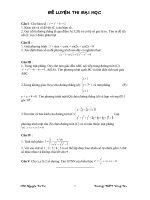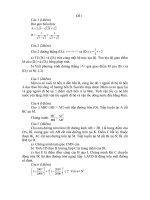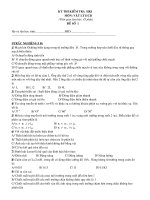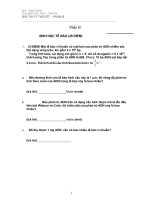DE THI OLYMPIC QUOC TE THAM KHAO
Bạn đang xem bản rút gọn của tài liệu. Xem và tải ngay bản đầy đủ của tài liệu tại đây (26.33 KB, 3 trang )
<span class='text_page_counter'>(1)</span><div class='page_container' data-page=1>
<b>LIÊN HỆ Mr. QUỐC: 0902.820.837</b>
<b>Exam II, Chemistry 4610/5560, Fall 2005 </b>
<b>Department of Chemistry, University ofNorth Texas, Dr. Mohammad Omary </b>
p. 1 of 3
<i><b>Student </b><b>name: </b><b> </b><b> </b></i>(1 pt)
(1) a) Construct molecular orbital schemes to describe the bonding in the following diatomic species. Fill the
electrons in the appropriate molecular orbitals and label the HOMO and LUMO. (18 pts)
O2 LiF NO
b) Determine the bond order, spin multiplicity, and magnetism (paramagnetic or diamagnetic) for each molecule.
(9 pts)
<i>Bond order </i> <i>Spin multiplicity </i> <i>Magnetism </i>
O2 :
LiF :
NO :
c) Explain whether you expect the bond in each molecule to become <i><b>stronger</b></i>, <i><b>weaker</b></i>, or <i><b>unchanged</b></i> upon
1-electron oxidation and 1-1-electron reduction. (6 pts)
<i>1-e oxidation </i> <i>1-e reduction</i>
O2 :
</div>
<span class='text_page_counter'>(2)</span><div class='page_container' data-page=2>
<b>LIÊN HỆ Mr. QUỐC: 0902.820.837</b>
<b>Exam II, Chemistry 4610/5560, Fall 2005 </b>
<b>Department of Chemistry, University ofNorth Texas, Dr. Mohammad Omary </b>
p. 2 of 3
(2) Use group theory to construct a reasonable molecular orbital scheme to describe the σ-bonding in the polyatomic
ions tetrahydroborate and nitrate. Fill the electrons in the molecular orbitals and label the HOMO and LUMO.
(24 pts)
</div>
<span class='text_page_counter'>(3)</span><div class='page_container' data-page=3>
<b>-LIÊN HỆ Mr. QUỐC: 0902.820.837</b>
<b>Exam II, Chemistry 4610/5560, Fall 2005 </b>
<b>Department of Chemistry, University ofNorth Texas, Dr. Mohammad Omary </b>
p. 3 of 3
(3) a) Give the predicted basicity order of NH3, CH3NH2, (CH3)2NH, and (CH3)3N in the gas phase. <i><b>Explain.</b></i>
(8 pts)
b) Why does the basicity order change when the same compounds act as Lewis bases with the Lewis acid B(<i>t</i>-Bu)3?
(4 pts)
c) Why does the basicity order change in aqueous solutions of the same compounds?
(4 pts)
(4) Answer parts a) and b) below in regard to the two following observations:
i) The Lewis acid AlF3 becomes soluble in hydrofluoric acid if NaF is present.
ii) When the other Lewis acid BF3 is subsequently added to the resulting solution in i), AlF3 precipitates.
a) Explain these two observations by writing the two chemical equations responsible for each observation. (6 pts)
i)
ii)
b) Explain why your equations above occur in the forward instead of the reverse direction. (4 pts)
i)
ii)
(5) Refer to the figure shown on the overhead showing the HOMO and LUMO for various species and then predict
the role of water when it reacts with the following species. You do <i><b>not</b></i> have to write chemical equations; just
indicate how you expect water to behave (<i>e.g.</i>, as an acid, base, oxidant, reductant, no reaction, etc.) <i><b>and explain </b></i>
<i><b>your answer.</b></i>
(16 pts)
a) Calcium metal
b) Cl-
c) Mg2+
d) F2
</div>
<!--links-->









